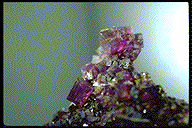

- Chemistry: NaCaAlF6 - H2O, Hydrated Sodium Calcium Aluminum Fluoride.
- Class: Halides
- Uses: As mineral specimens.
Specimens
Pachnolite forms from the alteration of
cryolite, another unusual halide mineral which by no small chance is associated with pachnolite.
Pachnolite also is found with the mineral
PHYSICAL CHARACTERISTICS:
- Color is colorless, white or stained yellow to brown by limonite.
- Luster is vitreous.
- Transparency: Crystals are transparent to translucent.
- Crystal System: Monoclinic.
- Crystal Habits include prismatic crystals with steep pyramidal terminations. Also pseudo-orthorhombic twinned prismatic crystals are common but tabular crystals are rare.
- Cleavage is very indistinct.
- Fracture is conchoidal.
- Hardness is 3
- Specific Gravity is 2.98 (average).
- Streak is white.
- Associated Minerals include
thomsenolite , cryolite,ralstonite and limonite. - Notable Occurrences are limited to Ivigtut, Greenland.
- Best Field Indicators are crystal habit, associations, locality and lack of good cleavage.





